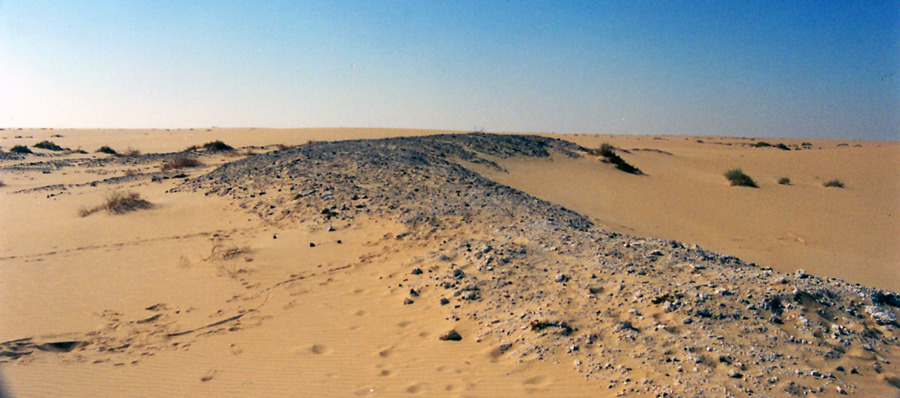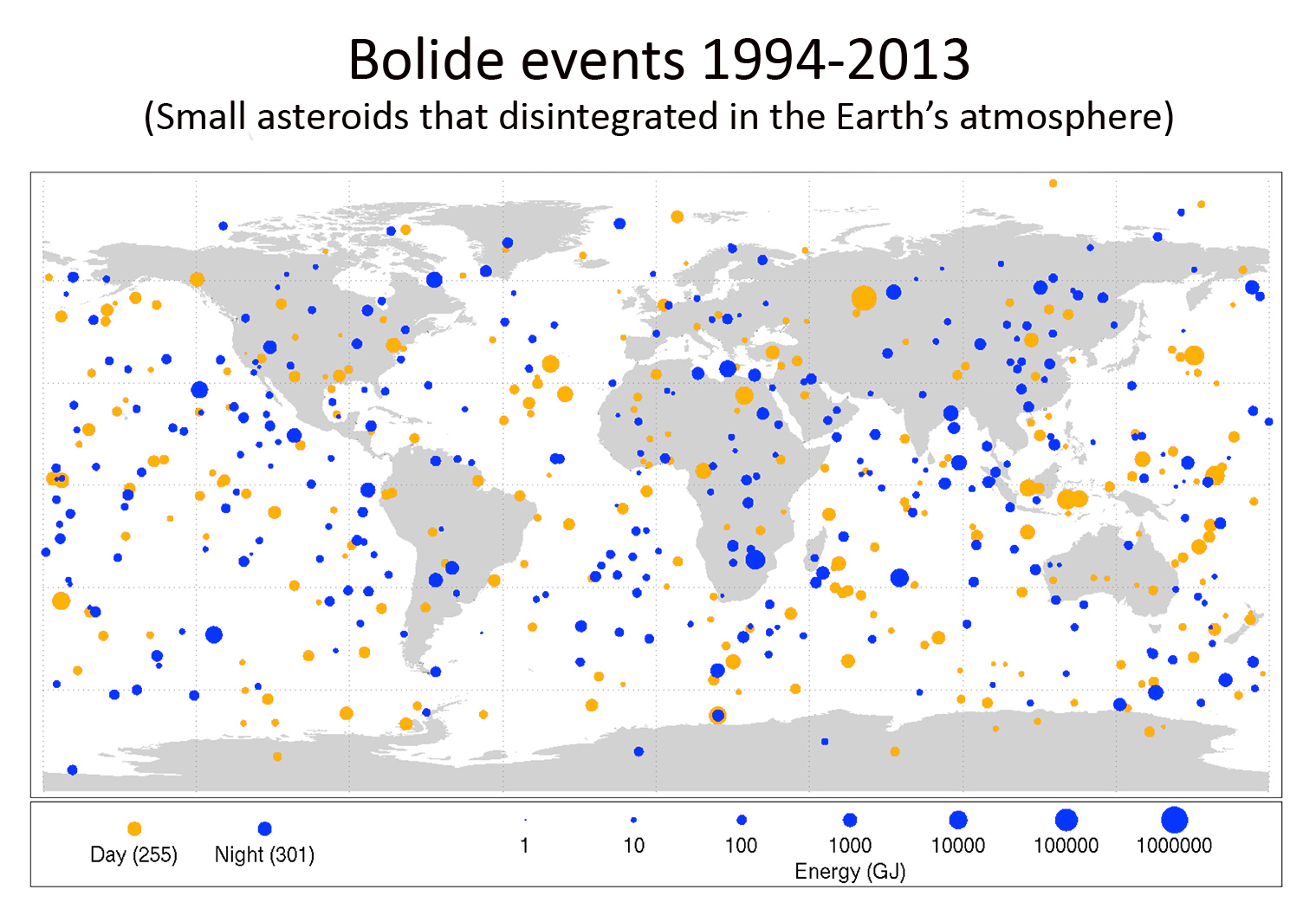100(ish) years of asteroid strikes:
If a rock hits you on the head the natural assumption is... someone threw it, the house is collapsing, a malicious hang glider dropped it.....well anything other than 'it dropped out of an empty sky'. Because the world doesn't work that way... except when it does.
In fact the main reason people don't get scares like that more often is just that it's a big ass planet Earth. Lots of it is uninhabited (or the ocean), and most people spend most of their time inside. The University of Western Ontario did a study of US early warning satellite readings over eight years. He identified 300 explosions caused by 1 to 10 m sized space rocks in that time. It happens a lot: below is a map of all the asteroid impacts over 9 years
The 'Little Boy' Hiroshima bomb would fall in between the second and third blobs on the right hand end of the scale - that's a lot of bang, but look how much falls over the ocean, or sparsely inhabited areas - it's no wonder most go unnoticed.
The reason why we don't all live in concrete and steel underground shelters is our planet's atmosphere, that heats most of them so much they explode well above ground height - without it this would happen fairly often:
OK, an asteroid that size would get through anyway. Somehow I never get tired of seeing CGI cities bite it....
...but bare in mind that (outside of Cameron land) that's a one in 10,000 year event, so please don't make like the citizens of Springfield.
Great daylight fireball, 1972:
I grew up with this one on screens and in pictures a lot - I'm a child of the 80's, and this was one of the first daylight-bright events to be captured on camera. It's thought to have been about three meters across, and travelling about 15 km per second - look at how it moves against the back ground clouds, and remember it's still over 50km up. The sheer speed is gobsmacking. It could have announced itself by finishing with a nuclear bomb sized explosion, but it after about a minute and a half this visitor skipped off the atmosphere and back into space.
Comet Shoemaker Levy 9, 1994:
Yes, I know, but I never said just impacts on Earth. Shoemaker-Levey 9 versus Jupiter was a great example of how gravity takes no prisoners: The comet was torn into a string of chunks by the gravity of the greatest giant planet, which were sucked down to their doom on the next orbit. Jupiter didn't get off un-bloodied though, as the impacting comet fragments became fireballs thousands of kilometres across, leaving clouds of debris bigger than Earth in the atmosphere for weeks afterwar4ds.
Carancas, 2007:
The Carancas strike in Peru was a rare example of an object getting to the ground intact enough to do some real harm:
 |
| Above: The crater at Carancas, Peru..Courtesy of The Meteorite Guy (that's him) |
 |
| Above: A fragment of the Carancs asteroid, showing the triangular Widmanstätten crystal pattern found in iron meteorites. Courtesy of the national museum |
The Moon doesn't have much of an atmosphere, so anything coming in with out a retro rocket hits hard. The tiny flash of light in this video would be a terrifying, lethal, blast if you were up close - it shows up on a world sized image, after all. A wandering space rock found the unyielding lunar rock in its path, and in an instant its kinetic energy - tens of kilometres per second worth - became heat and blast.
Wabar 1863/1891:
The tribes in desolate corner of Saudi Arabia told stories about something massive and bright that tore through the sky over their tents. When an expedition went to the area the object seemed to have come down in - an expedition actually searching for the lost city of Ubar (pronounced Wabar) - they found craters, the biggest of which was over a hundred meters across. Sand had been melted to glass by the heat, and fragments of nickel iron meteorite were mixed into it, producing the dark 'Wabar glass' that litters that part of the desert.
 |
| Above: The rim of one of the biggest craters. If there was a derelict city on this spot... there isn't one now... |
 |
| Above: A fragment of meteoric iron recovered from the Wabar crater, with the Widmanstätten crystal pattern. |
Tunguska, 1908:
In 1908 something came down over the forests of Siberia, in the Tunguska region. What the villagers of the area described sounded incomprehensible - a massive, unbearably bright light, an immense cloud of dust, and a roaring wind. Thousands of square kilometres of forest were flattened by an incomprehensible force: Trees flattened, branches blow off, laying in a titanic radial pattern - in the centre the trees had just been blasted straight down into the dirt. But there was no crater, and no fragments conclusively from an asteroid or comet were ever found. Had it hit a city, million would have died. A mystery like this needs a better mind than mine - so I'll hand you over to the legendary Carl Sagan:
Above: Ladies and gentlemen, I give you Carl Sagan.
Above: A computer simulation of one possible Tunguska fireball, courtesy of Sandia Labs.
Ann Hodges 1954:
Sometimes the universe gets personal. This must've been how Ann Hodges felt when a meteorite smashed through the roof of her house, bounced off of her radio, and hit her squarely in the hip. Bruised, but otherwise alright, she became famous overnight, as the first definite case of a person being inured by a space rock
 |
| Above: Ann shortly after she was hit (left), and many years later holding the space rock responsible (right0 |
This was an 80 ton space rock that blew up harmlessly over the Nubian desert in 2008. What was remarkable was that this was the first ever object to be detected (by the Catalina Sky Survey) before it hit.
 |
| Above: An infra red satellite image of the meteorite blowing up over the desert. |
Around 600 chunks were recovered, and turned out to be of a rare kind called ureillites.
It contained a lot of oddities, including nanodiamonds, and molecules from life-like chemistry, known as amino acids.
South Africa 2009:
South Africa got a visitor from space, and although not much was found of this one it's a good example of how mre and more impacts are being caught on cameras, worldwide:
South Africa got a visitor from space, and although not much was found of this one it's a good example of how mre and more impacts are being caught on cameras, worldwide:
Chelabisnk (Russia again), 2003:
If you missed hearing about this one... you must have been under the bed. For two years. But clearly you have internet there, so you should still know: By asteroid standards this was a fairly mild demonstration of power, but, still, the numbers are impressive: The 20 meter wide rock hit the atmosphere at nearly 70,000 kilometres an hour. It exploded twenty kilometres up, with the force of twenty Hiroshima bombs, and the fireball was brighter than the Sun even a hundred kilometres away. The blast wave triggered a magnitude 2.7 earthquake. And it was right over the city of Chelabinsk - thousands of people were injured, thousands of buildings damaged. And, by asteroid standards, this was still a tiny one.
If you missed hearing about this one... you must have been under the bed. For two years. But clearly you have internet there, so you should still know: By asteroid standards this was a fairly mild demonstration of power, but, still, the numbers are impressive: The 20 meter wide rock hit the atmosphere at nearly 70,000 kilometres an hour. It exploded twenty kilometres up, with the force of twenty Hiroshima bombs, and the fireball was brighter than the Sun even a hundred kilometres away. The blast wave triggered a magnitude 2.7 earthquake. And it was right over the city of Chelabinsk - thousands of people were injured, thousands of buildings damaged. And, by asteroid standards, this was still a tiny one.
Elsewhere in the universe:
Would you live out your life on Mars?
These folk would, and might, might, get the chance to do so.
Fall into a black hole:
The BBC gives a nice explanation of what happens to things falling into a black hole.... yes they end up very dead and crushed, but there's details that are interesting:
Elsewhere on the internet:
Why the Sun is actually green
MAVEN mission dips into the Martian atmosphere
Sun gives out polar jets
Dark matter turns lethal
Solar storm and Earth's magnetic field conspire to accelerate particles to incredible speeeds

No comments:
Post a Comment